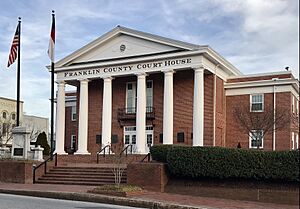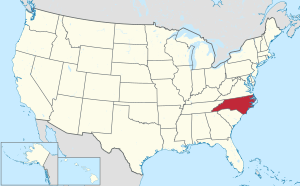Franklin County, North Carolina facts for kids
Quick facts for kids
Franklin County
|
|||
|---|---|---|---|

Franklin County Courthouse in Louisburg
|
|||
|
|||
| Motto(s):
"Leges Juraque Vindicamus" (Latin)
(We Defend Laws and Justice) "A Research Triangle Region Community" |
|||

Location within the U.S. state of North Carolina
|
|||
 North Carolina's location within the U.S. |
|||
| Country | |||
| State | |||
| Founded | 1779 | ||
| Named for | Benjamin Franklin | ||
| Seat | Louisburg | ||
| Largest community | Louisburg | ||
| Area | |||
| • Total | 494.57 sq mi (1,280.9 km2) | ||
| • Land | 491.80 sq mi (1,273.8 km2) | ||
| • Water | 2.77 sq mi (7.2 km2) 0.56% | ||
| Population
(2020)
|
|||
| • Total | 68,573 | ||
| • Estimate
(2023)
|
77,001 |
||
| • Density | 138.6518/sq mi (53.5337/km2) | ||
| Time zone | UTC−5 (Eastern) | ||
| • Summer (DST) | UTC−4 (EDT) | ||
| Congressional district | 1st | ||
Franklin County is a county located in the U.S. state of North Carolina. As of the 2020 census, the population was 68,573. Its county seat is Louisburg. Franklin County is included in the Raleigh-Cary, NC Metropolitan Statistical Area, which is also included in the Raleigh-Durham-Cary, NC Combined Statistical Area, which had an estimated population of 2,368,947 in 2023.
History
The county was formed in 1779 from the southern half of Bute County. It is named for Benjamin Franklin. It is a part of the Research Triangle.
County formation timeline
- 1664 – Albemarle County formed (original, extinct)
- 1668 – Albemarle County subdivided into Carteret, Berkeley, & Shaftesbury Precincts
- 1681 – Shaftesbury Precinct renamed Chowan Precinct
- 1722 – Bertie Precinct formed from Chowan Precinct
- 1739 – Bertie Precinct becomes Bertie County
- 1741 – Edgecombe County formed from Bertie County
- 1746 – Granville County formed from Edgecombe County
- 1754 – Creation of Bertie Precinct, Edgecombe County, & Granville County repealed by King George II, in Privy Council
- 1756 – Bertie, Edgecombe, & Granville re-created
- 1764 – Bute County (extinct) formed from Granville County
- 1779 – Franklin County formed from Bute County (extinct)
- 1787 – Franklin County gains land from Wake County
- 1875 – Franklin County gains land from Granville County
- 1881 – Franklin County loses land to help form Vance County
School desegregation
The integration of Franklin County Schools in 1965–1968 was marked by a federal lawsuit and some violence against African-American residents. The North Carolina Humanities Council funded the Tar River Center for History and Culture at Louisburg College to prepare "An Oral History of School Desegregation in Franklin County, North Carolina."
County song
The "Franklin County Song" was selected in a 1929 contest by the county historical association as the song most suitable for public occasions. The words were written by Fred U. Wolfe, an agriculture teacher at Gold Sand. Sung to the tune "Maryland, My Maryland" ("O Christmas Tree"), the song was incorporated in the Bicentennial programs of 1979. At the evening convocation of January 29, Mrs. Beth Norris announced to the audience that Wolfe (retired and residing in North, South Carolina) was aware his song was part of the program that night.
With loyalty we sing thy praise,
Glory to thy honored name!
Our voices loud in tribute raise,
Making truth thy pow'r proclaim.
Thy past is marked with vict'ry bold;
Thy deeds today can ne'er be told,
And heroes brave shall e'er uphold
Franklin's name forevermore.
We love thy rich and fruitful soil,
Wood, and stream, and thriving town.
We love the gift of daily toil,
Making men of true renown.
Thy church and school shall ever stand
To drive the darkness from our land—
A true and loyal, valiant band,
Sons of Franklin evermore.
A shrine of promise, pow'r and truth,
Lasting righteousness and peace,
A land of hope for toiling youth,
Yielding songs that never cease.
Let ev'ry son and daughter stay
The hand of vice that brings decay.
When duty's voice we shall obey,
Franklin's name shall live for aye.
Geography
According to the U.S. Census Bureau, the county has a total area of 494.57 square miles (1,280.9 km2), of which 491.80 square miles (1,273.8 km2) is land and 2.77 square miles (7.2 km2) (0.56%) is water.
State and local protected areas
- Sandy Creek Game Land (part)
- Shocco Creek Game Land (part)
- V.E. and Lydia H. Owens Recreational Park at Bull Creek
Major water bodies
- Buffalo Creek
- Camping Creek
- Crooked Creek
- Fishing Creek
- Lake Royale
- Little River
- Sandy Creek
- Shocco Creek
- Tar River
Adjacent counties
- Warren County – northeast
- Vance County – north
- Granville County – northwest
- Wake County – southwest
- Johnston County – south
- Nash County – east
Major highways

 Future I-87
Future I-87 US 1
US 1 US 1A
US 1A US 64
US 64 US 401
US 401 NC 39
NC 39 NC 56
NC 56 NC 58
NC 58 NC 96
NC 96 NC 97
NC 97 NC 98
NC 98 NC 561
NC 561 NC 581
NC 581
Major infrastructure
- Triangle North Executive Airport
Demographics
| Historical population | |||
|---|---|---|---|
| Census | Pop. | %± | |
| 1790 | 7,502 | — | |
| 1800 | 8,529 | 13.7% | |
| 1810 | 10,166 | 19.2% | |
| 1820 | 9,741 | −4.2% | |
| 1830 | 10,665 | 9.5% | |
| 1840 | 10,980 | 3.0% | |
| 1850 | 11,713 | 6.7% | |
| 1860 | 14,107 | 20.4% | |
| 1870 | 14,134 | 0.2% | |
| 1880 | 20,829 | 47.4% | |
| 1890 | 21,090 | 1.3% | |
| 1900 | 25,116 | 19.1% | |
| 1910 | 24,692 | −1.7% | |
| 1920 | 26,667 | 8.0% | |
| 1930 | 29,456 | 10.5% | |
| 1940 | 30,382 | 3.1% | |
| 1950 | 31,341 | 3.2% | |
| 1960 | 28,755 | −8.3% | |
| 1970 | 26,820 | −6.7% | |
| 1980 | 30,055 | 12.1% | |
| 1990 | 36,414 | 21.2% | |
| 2000 | 47,260 | 29.8% | |
| 2010 | 60,619 | 28.3% | |
| 2020 | 68,573 | 13.1% | |
| 2023 (est.) | 77,001 | 27.0% | |
| U.S. Decennial Census 1790–1960 1900–1990 1990–2000 2010 2020 |
|||
2020 census
| Race | Number | Percentage |
|---|---|---|
| White (non-Hispanic) | 42,285 | 61.66% |
| Black or African American (non-Hispanic) | 15,785 | 23.02% |
| Native American | 259 | 0.38% |
| Asian | 452 | 0.66% |
| Pacific Islander | 17 | 0.02% |
| Other/Mixed | 2,813 | 4.1% |
| Hispanic or Latino | 6,962 | 10.15% |
As of the 2020 census, there were 68,573 people, 26,720 households, and 20,443 families residing in the county.
2010 census
At the 2010 census, there were 60,619 people, 23,023 households, and 16,317 families residing in the county. The population density was 123 people per square mile (47 people/km2). The racial makeup of the county was 66.0% White, 26.7% Black or African American, 0.5% Native American, 0.5% Asian, 0.0% Pacific Islander, 4.4% from other races, and 1.8% from two or more races. 7.9% of the population were Hispanic or Latino of any race.
There were 23,023 households, out of which 30.2% had children under the age of 18 living with them, 52.3% were married couples living together, 13.4% had a female householder with no husband present, and 29.1% were non-families. 24.2% of all households were made up of individuals, and 8.8% had someone living alone who was 65 years of age or older. The average household size was 2.56 and the average family size was 3.04.
In the county, the population was spread out, with 27.3% under the age of 20, 5.5% from 20 to 24, 26.2% from 25 to 44, 28.5% from 45 to 64, and 12.6% who were 65 years of age or older. The median age was 39.1 years. For every 100 females there were 99.1 males. For every 100 females age 18 and over, there were 97.0 males.
The median income for a household in the county was $41,696, and the median income for a family was $51,353. Males had a median income of $41,025 versus $34,562 for females. The per capita income for the county was $21,399. About 12.3% of families and 16.1% of the population were below the poverty line, including 20.6% of those under age 18 and 13.7% of those age 65 or over.
Housing
There were 26,577 housing units at an average density of 54 units per square mile (21 units/km2). 13.4% of housing units were vacant.
There were 23,023 occupied housing units in the town. 17,029 were owner-occupied units (74.0%), while 5,994 were renter-occupied (26.0%). The homeowner vacancy rate was 2.4% of total units. The rental unit vacancy rate was 7.6%.
Economy
The county's economy and population is growing due to its proximity to growth in Wake County.
Education
Franklin County Schools operates 16 schools throughout the county, ranging from pre-kindergarten through twelfth grade. They include four high schools, four middle schools and eight elementary schools.
Franklin County is home to the two-year Methodist-affiliated Louisburg College and to a satellite campus of Vance-Granville Community College.
Youngsville Academy, a college-preparatory, tuition-free charter school, opened in July 2015. Wake Preparatory Academy, a charter school with an enrollment of 750, opened in 2022.
Communities
Towns
- Bunn
- Franklinton
- Louisburg (county seat and largest community)
- Youngsville
Census-designated places
Unincorporated communities
- Alert
- Epsom
- Five Points
- Gold Sand
- Gupton
- Halls Crossroads
- Harris Crossroads
- Hickory Rock
- Ingleside
- Katesville
- Kearney
- Justice
- Laurel Mill
- Mapleville
- Margaret
- Mitchiners Crossroads
- Moulton
- Needmore
- New Hope
- Oswego
- Pearces
- Pilot
- Pine Ridge
- Pocomoke
- Raynor
- Riley
- Rocky Ford
- Royal
- Schloss
- Seven Paths
- Stallings Crossroads
- Sutton
- White Level
- Wilders Corner
- Wood
Townships
- Cedar Rock
- Cypress Creek
- Dunn
- Franklinton
- Gold Mine
- Harris
- Hayesville
- Louisburg
- Sandy Creek
- Youngsville
See also
 In Spanish: Condado de Franklin (Carolina del Norte) para niños
In Spanish: Condado de Franklin (Carolina del Norte) para niños



